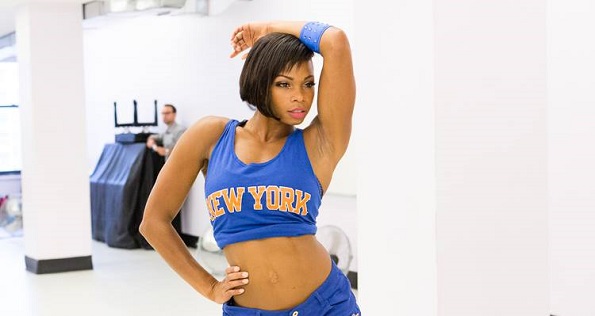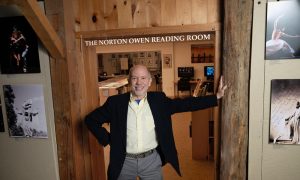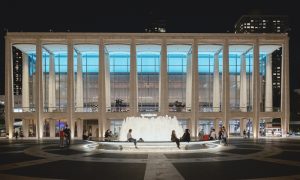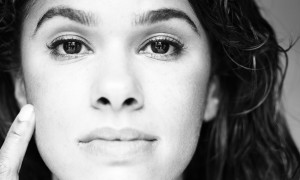By Mary Callahan of Dance Informa.
Few dancers would refute the belief that dance is not only an art, but also a sport. And thanks to Misty Copeland’s new campaign for Under Armour, naysayers are swallowing their words, too. Nevertheless, the connection between fitness and dance is still pretty cloudy—How can dancers negotiate their personal health with the physical aesthetics that are still so emphasized in the dance world? To try and answer this tough question, Dance Informa sat down with Chelsea Simone, a Knicks City Dancer and personal trainer at Equinox.
When did you start dancing? What styles did you study and when did you realize you wanted to pursue a career as a professional dancer?
“I started dancing when I was four years old. I think that I kind of always knew that I wanted to pursue it as a career, but it solidified when I first saw Alvin Ailey American Dance Theater when I was 14. I attended Fordham University and the Ailey School to earn a bachelor’s in dance through their joint Bachelor of Fine Arts program. I trained in Horton, Graham-based modern, West African dance and acting and joined Fordham University’s only hip-hop dance team, Fordham Flava Dance Company. This was my first experience with hip-hop dance and I became immediately enthralled with the style. While in college, I also learned about the importance of cross-training for dancers. I learned that strength training could help make me a stronger, more powerful dancer.”
Describe your health and fitness (and knowledge of those fields) growing up.
“Health—in terms of the food that I was eating—I didn’t really make it a priority until I was in college. Then, the priority was eating on a budget (lots of ramen that I tried to spice up with eggs, green onions and hot sauce). However, I was always focused on the physical aesthetics of a dancer’s body, particularly my abdominals, which is understandable considering that quite a few of my costumes were two pieces. I would do crunches all the time and over school breaks I would do Pilates everyday. Because there is such a heavy focus on the physical aesthetics of dance, I was very focused on fitness from the outside, but not necessarily my health from the inside.”
What was the process like to become a personal trainer? Do you continue to take classes and obtain different certifications?
“I became a personal trainer at Equinox a few years ago. The most difficult part of becoming a personal trainer is getting a certification. There are so many topics that I didn’t even consider to be under my scope of practice as a trainer, but in order to build a reputation as a good trainer and have a long-lasting career, there’s so much knowledge to be obtained. I’m constantly looking to learn more—but certifications are expensive. I have completed my national personal training certification, my pre-/postnatal certification and my Functional Movement Screen, Level 1 certification, but I’m constantly looking to learn more. I’m currently taking classes through Equinox to be promoted to a Tier 3 trainer.”
Do you believe your dancing has changed since you became a personal trainer? How so?
“My dancing has certainly changed since I became a trainer because I know so much more about human anatomy. I have a better understanding of how to move and what may be restricting a movement that I struggle with. I’ve also learned how to improve my core and joint stability to help me move more dynamically and balance better.”
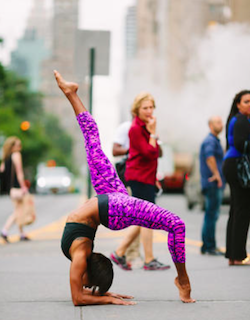
Chelsea Simone practicing yoga in NYC. Photo by Bizzy Armor Photography
How does your career as a personal trainer affect you as a Knicks City Dancer?
“The two jobs compliment each other very well. Being a personal trainer allows me to have a fairly flexible schedule so I can attend games, appearances, and rehearsals. It also, of course, keeps me injury-free during basketball season and in shape during off-season.”
What is your favorite part about being a Knicks City Dancer?
“My favorite part about being a KCD is being on a team with such inspiring, intelligent, confident, and empowering women.”
Describe a typical day.
“Is there such a thing?! Well, my schedule is all over the place. I generally start work at 6:30am and, depending on the day, could only have two morning sessions before a break or I could have five. Then I have a few lunchtime clients and a few evening clients. I also have Knicks City Dancers rehearsals twice a week. That’s the general skeleton, but there’s a whole bunch of other stuff thrown in there (KCD appearances and games, fitness photo shoots, and my own fitness regime at the gym). I manage to keep my life together by keeping a very organized, color-coded schedule.”
Dancers often adopt unhealthy habits (whether its an eating disorder or not cross-training or living off of junk food). What advice can you give to fellow dancers in terms of health and fitness?
“When it comes to a point in any career where you’re making choices that change who you are or are detrimental to your health, you have to reevaluate why you’re investing time in that career and who you’re truly doing it for; it should be for you. For a little while in college I had in fact started to adopt unhealthy eating habits in that I started to eat smaller meals after I was told several times to lose 5-7 pounds. But I just felt awful and my dancing did not improve—in fact, I was more exhausted and injury-prone. So I gave that up, started eating full, hearty, healthy meals and just focused on being the best dancer that I could be.”
There are a lot of fad fitness crazes that promise you a “dancer’s body” (barre classes, Pilates, dance cardio) and at the same time there are exercises that dancers are told to never do (i.e. running, lifting heavy weights, etc.). What do you make of these myths?
“First of all, what is a “dancer’s body?” Misty Copeland has completely changed the image of a “dancer’s body” from a frail-thin frame to a strong, womanly, powerful athlete. I have a chest and a butt and thighs, does that make me any less of a dancer? Absolutely not! Since I began focusing on my inner fitness (rather than just outer aesthetics), I’ve become the best dancer of my life—and continue to grow everyday.
The only way to get a true “dancers body” is to train like a dancer. Your body will adapt the only way it knows how. In terms of exercises dancers should never do, I believe that there’s no such thing (since dancers are truly athletes). If it’s safe for you, I think it’s ok to do it. Lift all the heavy weights you want! I do.”
Photo (top): Knicks City Dancer Chelsea Simone. Photo courtesy of Knicks City Dancers.


